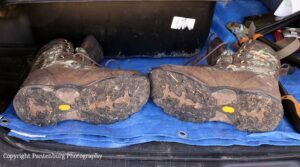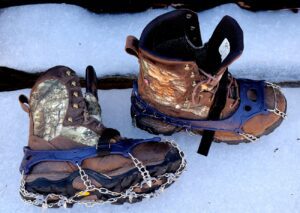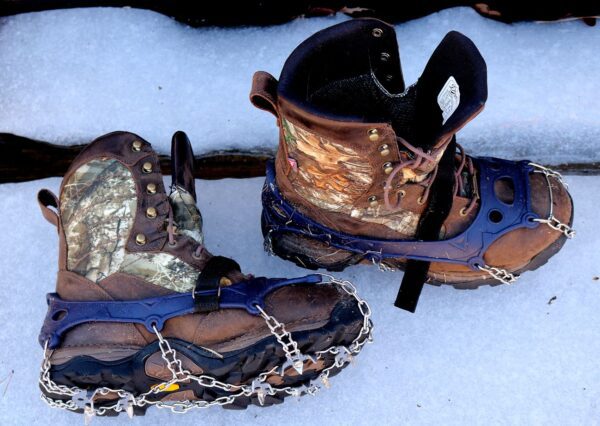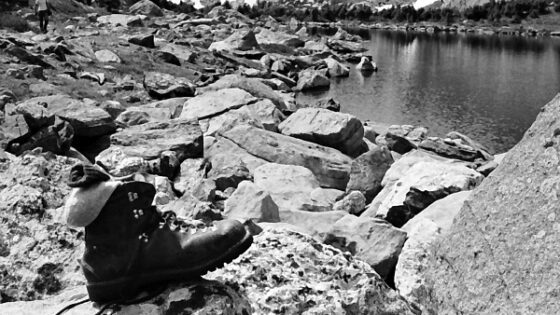Your boots can make or break your hunting trip.
These classic boots, proven in the field for almost two decades, might be what you are looking for.
by Leon Pantenburg
Disclaimer: Danner supplied the product used in this review. I don’t work for Danner and I was not paid to write this review. The review is strictly my opinion, and nobody had any input into the contents. At the time of publication, there was no sponsorship relationship between Danner and Survivalcommonsense.com.
When it comes time to replace outdoor gear, I check around among my hunting and hiking buddies to find out what they are using and how they liked them. My longtime hunting partner, brother Michael Pantenburg, bought a pair of Danner Pronghorns several years ago after one of his hunting partners bought a pair. Both hunt the Idaho backcountry and they use their gear hard.
I was looking for a light to moderately-insulated boot that would work well in the Mississippi swamps and Oregon high desert areas I hunt. The boot needed to be lightweight, but warm down to about 30 degrees. It would need solid ankle and foot support, with an aggressive tread pattern on the sole.

My Pronghorns were used a lot last deer season.
Comfort was paramount – cold, wet feet are awful. Since I do a lot of hiking and glassing on a hunt, the boot would also have to be good for hiking.
Danner’s Pronghorn series has been around for some 20 years, and has gone through five generations of improvement and refinement. Upon the recommendation of my brother and other experienced users, I got a pair of Pronghorns.
Pronghorn Specifications
| Style | 41341 |
|---|---|
| Weight | 56 oz per pair |
| Height | 8″ |
| Insulation | 400G PrimaLoft® |
| Color | Brown |
| Camo Pattern | Realtree Edge™ |
| Footbed | Polyurethane |
| Shank | Bi Fit Board |
| Last Type | 851 |
| Lining | Waterproof |
| Liner | GORE-TEX |
| Recraftable | No |
| Manufacturing | Imported |
Here’s how the Pronghorns worked out for me:
Break-in: A tough, sturdy boot is going to take longer to break in than more lightweight footwear. My Pronghorns were never uncomfortable, but it took a lot of miles (I’m guessing about 30, done on an asphalt track) before they were really comfortable. For a while, both boots rubbed on the inside of my ankles, and no matter how I laced them, there was still pressure in that area. At one point, I considered sending the Pronghorns back to Danner, but decided to keep wearing them. (It’s hard for me to give up on a product with proven capabilities!) Then one afternoon, the boots just quit rubbing.
Insulation: The 400 grams of PrimaLoft® InsulationPrimaLoft® Gold Insulation was just right for all the hunting I did down to about 25 degrees. This covers about 90+ percent of all my southeastern hunting. The Pronghorns were my go-to boots this deer season and they performed up to my expectations.
Camo pattern on uppers: These fool more shoppers than game animals. I guess it’s OK, but the camo is not a selling point for me. According to the website: Realtree® EDGERealtree EDGE camo allows you “to blend into your hunting environment at close range, with natural elements arranged in a way to disrupt the human form at a distance.”
Liner: I don’t like Gore-Tex® or any of the boot liners that claim to let interior moisture out, while keeping exterior moisture from getting in. I have yet to find a moisture barrier boot liner (or raingear) that can dissipate moisture as fast as it is generated.
A waterproof liner can be valuable in some environments – like swamps – where there is standing water, or in snow that is freezing and thawing. But your feet will still inevitably get wet from perspiration.
A warning about boots with waterproof liners: Make sure to dry the boots at night, even if they don’t seem really wet, and wear wool socks that are changed frequently.

These Hillsound crampons worked really well with the Pronghorns to safely walk over ice.
Sole: I walked in wet oak leaves on clay, snow and ice and mud. The tread pattern worked very well. The tread never clogged up, and the sole worked as well as could be expected under the different circumstances.
During a recent ice storm, I hiked about 12 miles in the Pronghorns. The conditions were about as bad as could be imagined – in some instances, I was walking on ice with water running over it. No standard sole could have handled that situation. My crampons allowed me to walk safely.
How It Fits: The 851 last is an update to Danner’s popular 850 last. This last fits true to size with an athletic and supportive fit while providing ample room in the toe. The heel shape that locks the heel in place for better fit and comfort on the back end of the boot, this supportive fit is ideal for those needing high mileage performance from their gear.
Pronghorns come in a wide width that is great for me. I can tighten the boots and still have room to wiggle my toes, even when wearing thick socks. This is one criteria for warm feet.
365-Day Warranty: Danner offers a 365-day warranty across their entire footwear line. Make sure you keep your receipt.
Imported: Danner made its reputation for quality footwear in Oregon, starting in 1932. Pronghorns are made overseas. I wish Danners were still made in Portland, Oregon. When a product is American made, that means that the workers make a fair wage under safe working conditions. The workers and factory pay local, state and federal taxes, and the craftspeople contribute to their communities. There are many quality products imported from overseas, but consider the hidden costs before you opt for a cheaper imported product.
Do you need a pair of Pronghorns?
I like mine, and so do the other hunters I’ve talked with. Pronghorns are a little heavy for an out-and-out hiking boot, and the added height also adds weight. Insulated Pronghorns would not be my first choice for a backpacking boot in warm environments. I also find that the moisture barrier liner makes the boots hotter than necessary.
For upland game hunting, pursuing chukers, quail or pheasants, an uninsulated Pronghorn, with no moisture barrier would be great. (Check out these Danner Incursions – they are my choice for a warm weather upland boot.)
But all in all, the Pronghorns are great as a hunting boot, and I will be using mine a lot in the field.
Please click here to check out and subscribe to the SurvivalCommonSense.com YouTube channel – thanks!




Kim Korton
Hey Leon,
I just finished reading your review on the Danner Pronghorn boots, and I had to drop a comment to say how much I loved it. First off, your writing style is so engaging and friendly; it feels like chatting with a good friend about outdoor gear over a campfire. Kudos to you for making product reviews exciting and informative at the same time!
As an avid hiker and nature enthusiast, I’m always on the lookout for top-notch gear, and your review has definitely caught my attention. The way you detailed your experiences with the Danner Pronghorns, from testing them in rugged terrains to discussing their comfort and durability, was truly helpful. It’s like you anticipated all the questions I had in mind and addressed them in such a natural and relatable manner. Your honest take on both the pros and cons gave me a realistic expectation of the boots, and I appreciate that transparency.
Your passion for the outdoors shines through your writing, and it’s contagious! Thanks for sharing your experiences and knowledge with us. I’ll definitely be considering the Danner Pronghorns for my next hiking adventure, all thanks to your fantastic review. Keep up the excellent work, and I’ll be eagerly waiting for more of your articles to fuel my wanderlust and gear obsession! Happy trails! 🏔️🥾